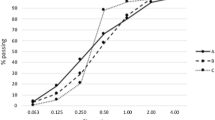Abstract
The hygrometric behaviour of four artificial stone materials utilised in the building industry for thermal insulation has been investigated utilising analytical methods typical of the applied petrography. The experimental data on the water absorption both in the liquid and in the vapour phase are in agreement with the data obtained from the natural stone materials and point out the existence in each material of a strong correlation between the absorption mechanisms and the porosimetric characteristics.
Résumé
On a étudié, à l’aide de méthodes analytiques utilisées en pétrographie appliquée, le comportement hygrométrique de quatre matériaux pierreux artificiels utilisés dans l’industrie du bâtiment pour leurs propriétés d’isolants thermiques. Les données expérimentales sur l’absorption d’eau aussi bien à l’état liquide qu’à l’état de vapeur, sont en accord avec les données obtenues sur les matériaux pierreux naturels, c’est-à-dire que dans chaque matériel il y a de fortes corrélations entre les mécanismes d’absorption d’eau et les caractéristiques porosimétriques.
Similar content being viewed by others
References
Bird, R. B., Stewart, W. E. and Lighfoot, E. N., ‘Transport phenomena’, (Wiley, New York, 1960).
Welty, I. R., Wicks, C. E. and Wilson R. E., ‘Foundamentals of momentum, heat and mass transfer’, (Wiley, Toronto, 1984).
Brodkey, R. S. and Hershey, H. C., ‘Transport phenomena—A unified approach’, (McGraw-Hill Co., Singapore, 1988).
Boekwig, W. O., ‘Determination of thermal conductivity and moisture content of stone building materials’, Concept IBBC-rapport BI., (1988), 88–129.
De Wit, M. H., Shellen, H. L. and Pel, L., ‘Measuring methods of moisture in solids’, Seminar and Workshop on Rising Dampness, Bari, (1991).
Cengel, Y. A., ‘Introduction to thermodynamics and heat transfer’, (McGraw-Hill Co., New York, 1997).
NORMAL 7/81 ‘Water absorption through total immersion—Imbibition coefficient’, (CNR-ICR, Roma, 1981).
NORMAL 11/85 ‘Capillary water absorption-capillary absorption coefficient’, (CNR-ICR, Roma, 1985).
NORMAL 21/85 ‘Water vapour permeability’, (CNR-ICR, Roma, 1985).
UNI Standard 10351 ‘Building Materials-Thermal conductivity and vapour permeability’, (1994).
Barsottelli, M., Fratini, F., Giorgetti, G. and Manganelli Del Fà C., ‘Microfabric and alteration in the Carrara marble: a preliminary study’,Science and Technology for Cultural Heritage 7 (2) (1998) 109–120.
prEN ISO 13788, ‘Hygrothermal performance of building components and building elements—Internal surface temperature to avoid critical surface humidity and interstitial condensation’, (2000).
Author information
Authors and Affiliations
Additional information
Editorial Note The CNR (Consiglio Nazionale delle Ricerche) is a RILEM Titular Member. The University of Florence is a RILEM Associate Member.
Rights and permissions
About this article
Cite this article
Barsottelli, M., Cellai, G.F., Fratini, F. et al. The hygrometric behaviour of some artificial stone materials used as elements of masonry walls. Mat. Struct. 34, 211–216 (2001). https://doi.org/10.1007/BF02480590
Received:
Accepted:
Issue Date:
DOI: https://doi.org/10.1007/BF02480590




